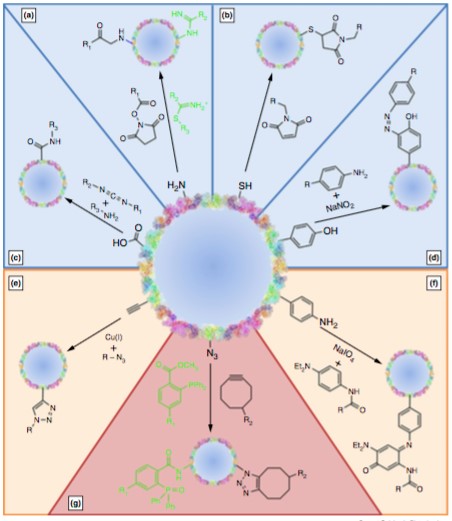Mempro™ Virus-like Particles (VLPs) Functionalization Strategies
Post-translational modification play a vital role in fully functionalizing the VLPs products. With the increasing demands to produce functional VLPs in a broad application fields, Creative Biostructure have established the advanced Mempro™ Virus-like Particles (VLPs) platform to manipulate VLPs genetically and post-translationally. We have developed various methods to precisely control VLPs traits such as size, stability, and reactivity. Creative Biostructure offers the following three functionalization strategies for Mempro™ Virus-like Particles (VLPs) services:
 Figure 1. Different covalent functionalization strategies for VLPs. (Current Opinion in Biotechnology, 2013)
Figure 1. Different covalent functionalization strategies for VLPs. (Current Opinion in Biotechnology, 2013)
• Mempro™ Virus-like Particles (VLPs) Genetic Functionalization Strategies
Genetically fusing VLPs with interested peptides can lead to external or internal decoration of the VLPs. Fusion VLPs have been applied in vaccines, delivery systems, and reactors in recent years. VLPs and antigen have a stable bond between them by this genetic linkage. By using molecular biology tools, Creative Biostructure can link the desired antigen to VLPs directly, however, we found peptides longer than 30 amino acids can interfere with the correct assembly of VLPs and inhibit VLPs function. Another limitation of genetic linkage is that VLPs will show heterogeneous size and improper folding with the linked peptides.• Mempro™ Virus-like Particles (VLPs) Noncovalent Functionalization Strategies
Creative Biostructure can perform noncovalent functionalization for VLPs through multiple ways such as electrostatic, protein-protein interactions, protein-nucleotide interactions, and protein-metal interactions. Creative Biostructure is able to encapsulate metals, quantum dots, fluorophores, pharmaceuticals, RNA, DNA, and proteins. The major disadvantage of noncovalent functionalization strategies for VLPs is that this kind of modification is often reversible in nature, particularly not favorable to maintain stable long-term binding.• Mempro™ Virus-like Particles (VLPs) Covalent Functionalization Strategies
Creative Biostructure can also functionalize VLPs by covalent approach with our scientific elites in peptide chemistry. Within the 20 natural amino acids (AAs), cysteine, lysine, aspartic acid, glutamic acid, and tyrosine particularly offer reactive side chain moieties which can form biocompatible covalent bonds. Creative Biostructure has successfully linked natural residues to several VLPs at their natural location. We also use more than 70 unnatural amino acids (uAAs) for VLPs covalent functionalization to allow greater flexibility in VLPs modifications in case that natural AAs damage the VLPs folding or function. Global-Replacement that is Residue-Specific (GRRS) and Site- Specific Incorporation (SSI) are two predominant methods for uAAs incorporation.We provide various Mempro™ Virus-like Particles (VLPs) Functionalization Strategies services. Please feel free to contact us for a detailed quote.
References:
M. T. Smith, et al. (2013). Reengineering viruses and virus-like particles through chemical functionalization strategies. Current Opinion in Biotechnology,24:620–626.
G. J. Tong, et al. (2009). Viral capsid DNA aptamer conjugates as multivalent cell-targeting vehicles. J. Am. Chem. Soc., 131:11174-11178.
A. Natilla, et al. (2011). Maize rayado fino virus virus-like particles expressed in tobacco plants: a new platform for cysteine selective bioconjugation peptide display. J. Virol. Methods, 178:209-215.